
The Mikoyan-Gurevich MiG-23 (МиГ-23 in Cyrillic script) (NATO reporting name 'Flogger') is a swing-wing fighter aircraft, originally built by the Mikoyan-Gurevich design bureau in the Soviet Union. Produced in large numbers, it remains in limited service with various export customers.
Development
The MiG-23's predecessor, the MiG-21(NATO reporting name 'Fishbed') , was fast and agile, but very limited in its operational capabilities, with primitive radar, short range, and a limited weapons load (restricted in some aircraft to a pair of short-range air-to-air missiles). The MiG-23 was to be a heavier, more powerful machine designed to remedy these deficiencies, and, it was hoped, rival Western aircraft like the F-4 Phantom. The new fighter was to feature the totally new S-23 sensor and weapon system suite capable of firing BVR missiles.
A major design consideration was take-off and landing performance. The Soviets' existing fast jets required very long runways, which, combined with their limited range, limited their tactical usefulness. The VVS demanded that the new aircraft have a much shorter take-off run. Also, low-level speed and handling was to be improved over MiG-21. This led Mikoyan to consider two alternatives: lift jets to provide an additional lift component and variable-geometry wings which had been developed by TsAGI for both 'clean-sheet' aircraft designs and adaptations of existing designs. The first prototype was a tailed delta, similar to MiG-21 but with two lift jets in the fuselage, and it was called 23-01, also known as MiG-23PD. However, very early it became apparent that this configuration was unsatisfactory, as lift jets were useless dead weight once airborne. The second prototype, known as 23-11, featured variable-geometry wings which could be set to angles of 16, 45 and 72 degrees, and it was clearly more promising. The maiden flight of 23-11 took place on 10 June 1967, and three more prototypes were prepared for further flight and system testing. All featured the Tumansky R-27-300 turbojet engine with thrust of 7850kp. The order to start series production of the MiG-23 was given in December 1967.
First generation MiG-23s
* MiG-23S (NATO codename 'Flogger-A') was initial preproduction variant. Only around 60 were built between 1969-70. These aircraft were used for both flight and operational testing. MiG-23S had improved R-27F2-300 turbojet engine with maximum thrust of 9980kp. As Sapfir-23 radar was delayed, aircraft were installed with S-21 weapons control system, with RP-22SM radar; it was basically same weapons system as in MiG-21MF/bis. Twin-barreled 23mm GSh-23L gun with 200 rounds of ammunition was fitted under the fuselage. This variant suffered from various teething problems and was never fielded as an operational fighter.
* MiG-23 was second pre-production variant, usually known as MiG-23 Type 1971. It was considerably modified compared to MiG-23S: it had full S-23 weapons suite, featuring Sapfir-23L radar and R-23R missiles. It also had furtherly improved R-27F2M-300 engine with maximum thrust of 12000kp (later redesignated R-29-300). Modified 'type 2' wing had increased wing area with 'dog tooth' leading edge. Slats were deleted and wing sweep was increased by 2.5 degrees; wing positions were changed to 18.5, 47.5 and 74.5 degrees respectively. Tail fin was moved aft, and an extra fuel tank was added to rear fuselage, as in twin-seater variant (see below). Around 80 examples were manufactured. Overall reliability was increased over previous variant, but Sapfir radar proved to be still immature.
* MiG-23M ('Flogger-B'). This variant first flew at June 1972. It was the first truly mass-produced version of MiG-23, and the first VVS fighter to feature look down/shoot down capabilities (although this capability was initially very limited). Wing was modified again and now featured leading-edge slats. R-29-300 engine was now rated for 12500kp. It finally had the definitive sensor suite: improved Sapfir-23D (NATO codename 'High Lark') radar, TP-23 IRST sensor and ASP-23D gunsight. The radar had a detection range of some 45km against a high-flying fighter-sized target. It was not a true Doppler radar, but instead utilised less effective 'envelope detection' technique, similar to some 1960s Western fighter radars. The infrared system had detection range of around 30km against high-flying bombers, less for fighter-sized targets. The aircraft was also equipped with Lasur-SMA -datalink. Standard armament consisted of two radar- or infrared guided R-23 (NATO codename: AA-7 'Apex') BVR missiles and two R-60 (AA-8 'Aphid') short-ranged infrared missiles. From 1974 onwards, double pylons were installed for R-60s, enabling up to four missiles carried. Bombs, rockets and missiles could be carried for ground attack. Later, capability for radio-guided Kh-23 ground attack missile was added. Most Soviet MiGs were also wired to carry tactical nuclear weapons. Some 1300 MiG-23M's were produced for VVS and PVO between 1972-78. It was the most important Soviet fighter type from mid-to-late 1970s.
* MiG-23UB ('Flogger-C'). A twin-seated training variant. It was based on MiG-23S, but featured second cockpit behind the first. One forward fuel tank was removed to accommodate extra seat, this was compensated by adding a new fuel tank in rear fuselage. It had S-21 weapon system, though radar was later mostly removed. During its production run, both wings and engine were improved to MiG-23M standard. The production began at Irkutsk in 1971 and continued until 1985 (export variant). Total of 769 examples were built.
* MiG-23MS ('Flogger-E'). This was an export variant as in the '70s MiG-23M was considered too advanced to be exported to Third World countries. It was otherwise similar to MiG-23M, but it had S-21 standard weapon system, with RP-22SM ('Jay Bird') radar in a smaller radome. IRST was removed. Obviously, this variant had no BVR capability, as it was capable of using only R-3S and R-3R (AA-2 'Atoll') and R-60 missiles. Avionics suite was very basic. This variant was produced between 1973-78 and exported to North Africa and Middle East.
* MiG-23MF ('Flogger-B'). This was another export derivative of MiG-23M, intended to be exported to Warsaw Pact countries but it was also sold to many other allies and clients, as most export customers were dissatisfied with rather primitive MiG-23MS. It actually came in two versions: first one was sold to Warsaw Pact allies, and it was essentially identical to Soviet MiG-23M, with small changes in IFF and communications equipment. Second variant was sold outside Eastern Europe and it had different IFF and communications suite (with datalink usually removed) and downgraded radar, which lacked the anti-ECM features and modes of the baseline 'High Lark'. This variant was more popular abroad than MiG-23MS and considerable numbers were exported especially to Middle East.
Second generation MiG-23s
* MiG-23ML ('Flogger-G'). The early Flogger variants were intended to be used in high-speed missile attacks, but it was soon noticed that very often fighters had to engage in more stressful close-in combat. Early production aircraft had actually suffered cracks in the fuselage during their service career. Maneuverability of the aircraft was also criticized. A considerable redesign of the airframe was performed, resulting in MiG-23ML (L - lightweight) which was in some ways a new aircraft. Empty weight was reduced by 1250kg, partly achieved by removing rear fuselage fuel tank. Aerodynamics were refined for less drag. Dorsal fin extension was removed. Undercarriage was redesigned, resulting to lowered nose attitude on the ground. Airframe was now rated for g-limit of 8.5g , compared to 8g for early generation MiG-23M/MF Flogger B. A new engine model R-35F-300 now had a maximum dry thrust of 8550kp, and 13000kp with afterburner. This led to considerable improvment in maneuverability and thrust-to-weight ratio.
Avionics set was considerably improved as well. S-23ML standard included Sapfir-23ML radar and TP-23ML IRST. New radar was more reliable and had maximum detection range of about 65km against fighter-sized target (25km in look-down mode). Navigation suite was improved especially with new autopilot. New radio and datalink system were installed. The prototype of this variant first flew in 1976 and production began 1978.
Later production variant of ML was called MLA. It had improved radar with better ECM resistance, which made co-operated group search operations possible as radars would not jam each other. It also had new ASP-17ML HUD/gunsight, and capability to fire improved R-24R/T missiles. Externally, MLA was identical to ML. Between 1978 and 1982, around 1100 ML/MLAs were built both to Soviet air force and export customers. As with MiG-23MF, there were two different MiG-23ML sub-variants for export: the first version was sold to Warsaw Pact countries and was very similar to Soviet aircraft. The second variant had downgraded radar and it was sold to Third World allies.
* MiG-23P ('Flogger-G'). This was a specialized interceptor variant developed to Soviet Air Defence Forces (PVO). It had same airframe and powerplant as MiG-23ML, but its avionics suite was improved to meet PVO requirements and mission profiles. Radar was improved Sapfir-23P which could be used in conjuction with IRST and gunsight for better look down/shoot down capability, to counter increasing low-level threats like cruise missiles. Autopilot included a new digital computer and it was linked with Lasur-M datalink, which enabled CGI ground station to steer the aircraft towards the target - in such intercept, all the pilot had to do was control the engine and use weapons. MiG-23P was the most numerous PVO interceptor in the 1980's. Around 500 aircraft were manufactured between 1978-81. MiG-23P served only within PVO, and was never exported.
* MiG-23MLD ('Flogger-K') was the ultimate fighter variant of MiG-23. The main concern of the upgrade was to improve maneuverability, especially high angles of attack. Pitot boom was equipped with vortex generators. Wings' notched leading edge roots were 'saw-toothed' to act as vortex generators as well. Flight-control system was modified to improve handling and safety in high AoA maneuvers. Signifant improvments were made in avionics and survivability: Sapfir-23MLA-II featured improved modes for look down/shoot down and close-in fighting. A new SPO-15L radar warning receiver was installed, along with chaff/flare dispensers. New and very effective R-73 (AA-11 'Archer') short-range air-to-air missile was added to inventory.
No new-built MLD aircraft were delivered to VVS, as more advanced MiG-29 was about to enter production. Instead, all Soviet MLD's were former ML/MLA aircraft modified to MLD standard. Some 560 aircraft were upgraded between 1982-85. As with earlier MiG-23 versions, two distinct export variants were offered. Unlike Soviet examples, these were new-built aircraft, though they lacked aerodynamic refinements of Soviet MLD's. 16 examples were delivered to Bulgaria, and 50 to Syria. These were the last single-seat MiG-23 fighters made: last example rolled off the production line in December 1984.
Ground attack variants
* MiG-23B ('Flogger-F'). Requirement for new fighter-bomber had became obvious in the late 1960s, and MiG-23 appeared to be suitable asset for such conversion. First prototype of the project 32-34 flew first time on August 20, 1970. It was otherwise similar to MiG-23S, but it had redesigned forward fuselage. Pilot seat was raised to improve visibility. Windscreen was armored. Nose was flat-bottomed and tapered down. There was no radar, instead it had Sokol-23 ground attack sight system, which included analog computer, laser rangefinder and PBK-3 bomb sight. Navigation suite and autopilot were improved to provide more bombing accurate. Maximum warload was increased to 3000kg by strengthening the pylons. GSh-23L gun was retained. Survivability was improved by EW suite and inert gas system in fuel tanks to prevent fire. First prototype had MiG-23S type wing, but subsesquent examples had larger 'type 2' wing. Most importantly, instead of R-29 -variant, aircraft was powered by AL-21F-3 turbofan with maximum thrust of 11 500kp. The production of this variant was limited, however. Supply of AL-21 -engines was needed for Su-17 and Su-24 production lines. In addition this engine was not cleared for export. Only three prototypes and 24 production aircraft were made in 1971-72.
* MiG-23BN ('Flogger-H') was the definitive fighter-bomber variant. It was otherwise same as MiG-23B, but had R-29-300 engine, same as contemporary fighter Floggers. They were also fitted with 'type 3' wings. There were other minor changes in electronics and equipment, and some changes were made during its long production run. This variant proved to be fairly popular and effective and it was extensively exported. As usual, downgraded version was sold to Third World customers. Serial production began in 1973 and lasted until 1985, with at least 500 examples built. Most of them went to export, as Soviets always viewed it as an interim type and only small number served in Frontal Aviation regiments.
* MiG-23BM ('Flogger-D'). MiG-23BN had too much "fighter heritance" for an attack aircraft and new design with more radical changes was developed. This was eventually renamed as MiG-27 and is described in that entry.
Proposed variants and upgrades
MiG-23R was a proposed reconnaissance variant. Project was never finished. MiG-23MLGD, MLG and MLS were further fighter upgrades with new radar and EW equipment, partly same as in MiG-29. However, they were abandoned in favour of MiG-29. MiG-23K was a carrier-borne fighter variant based on MiG-23ML, and MiG-23A was a multirole-variant from K. However, cancellation and subsesquent redesign of Soviet aircraft carrier project also caused cancellation of these variants.
At late '90s, Mikoyan Design Bureau, following their successful MiG-21 upgrade projects, offered a MiG-23-98 upgrade which featured a new radar, new self-defence suite, new avionics, improved cockpit ergonomy, helmet-mounted sight and capability to fire R-27 and R-77 missiles. Projected cost was around $1 million USD per aircraft. Smaller upgrades were also offered, which consisted of only improving existing Sapfir-23 to employ newer missiles and upgrade of other avionics. Airframe life extension is offered as well. However, so far these upgrades have been met with little interest but Angola has taken in 2005 an upgrade of the Saphir radar fitted to it`s MiG-23ML to allow new weapons to be fired by it which seems to be the MiG-23-98-2 upgrade.
Total production of MiG-23 fighter, attack and trainer versions was over 5000 aircraft (not including MiG-27), of which 3630 were fighter variants.
Service career
MiG-23 first saw combat over Middle East. Early fighter variants did not perform particularly well, partly owing to their limitations. For example, MiG-23MS lacked such a basic system like radar warning receiver. In addition, compared to MiG-21, the aircraft was mechanically complex and expensive. Early export variants also lacked many "war reserve modes" in their radars, making them vulnerable against ECM, in which Israeli were especially proficient. MiG-23MS/MF took part to various Arab-Israeli conflicts and Iran-Iraq war, but their success was poor. Part of it was caused by that most export customers lacked extensive GCI networks which Soviets were employing directing their interceptors. On a plus side, MiGs excellent acceleration ofter enabled it to escape disadvantageous situations. Ground-attack variant MiG-23BN, on the other hand, was considered quite effective. In the '80s, an improved MiG-23ML was widely exported and that new variant performed better and was met with more enthusiasm by end-users.
According to different Arab, Cuban and Russian reports the MiG-23 achieved victories over the F-4 Phantom, Mirage F1, F-5 Freedom Fighter, A-4 Skyhawk in different wars throughout the Middle East and Africa. However in most cases these have been difficult to verify or accept by western experts nevertheless Russian books and sources accept them as valid and they even go much further as to claim even some F-16 and a Panavia Tornado fell pray to Syrian, Iraqi and Soviet MiG-23s however most Middle-East air forces are not particularly forthcoming about their losses and Western and Russian experts usually had some degree of disagreement due to the bias they practice for their own respective national aircraft industries. It is known that some number of air victories was scored by MiG-23s in Iran-Iraq war. Cuban MiG-23MLs and South African Mirage F.1s had several largely inconclusive encounters during Angolan War, during which one Mirage was damaged by R-23 or R-60 missile and had to be rebuilt and another was shot down according to Cuban reports. Soviet MiG-23MLDs and Pakistani F-16s clashed few times during Afghanistan War but again, neither side scored any victories against each other to be acknowledged in the West due to the misinformation and contradiction of such claims by both warring sides, although one F-16 was reportedly lost in a friendly fire incident during these clashes by Pakistan however Russian reports claim at least one F-16 was shot down by a MiG-23MLD.
Few pictures and footage have been released of MiG-23 air to air combat losses except a picture of the wreckage of a Syrian MiG-23 shot down by Israeli forces and the US Navy film footage of the shooting of two Libyan MiG-23MS by a pair of US Navy F-14s.
At 1990, over 1500 MiG-23s of different models were in service within VVS and PVO. With the dissolution of Soviet Union, Russian Air Force began to cut back its fighter force, and it was decided that MiG-23 and MiG-27 were amongst the types which were to be retired. The last model to serve was MiG-23P within PVO, last examples were retired in 1998. Several hundred airframes are stored, though their condition is questionable. Amongst foreign users, most user countries have experienced severe economical difficulties since dissolution of Soviet Union, resulting to military cutbacks. Relatively complex MiG-23's were often retired in favour of simpler types like MiG-21. Despite this, several hundred MiG-23's remain in service, mostly variants ML and BN. Current and former users include Afghanistan, Algeria, Angola, Belarus, Bulgaria, Cuba, Czechoslovakia, East Germany, Egypt, Ethiopia, Hungary, India, Iraq, Kazakhstan, Libya, North Korea, Poland, Romania, Russia, South Yemen, Sudan, Syria, Turkmenistan, Ukraine and Vietnam.
Western pilots who flew the MiG-23 claimed the MiG-23's handling was similar to something between the F-4E and Panavia Tornado in some parts of the flight envelope, and in others more like the F-105 however Soviet Manuals gave to the MiG-23MLD a performance and handling superior to the F-4E and in some parts of the flight envelop better than the F-16A but admitted the overwhelming superiority the F-15 has over the MiG-23 family . The Israelis tested the MiG-23 and found it had better acceleration than the F-16 and F-18. It should be noted that different variants often had signifant differences in their handling qualities. Overall, MiG-23 represents final incarnation of late 1960s fighter technology which, despite being developed close to its full potential, was quickly overtaken by next generation fighters like F-16 and MiG-29 which employed doppler radars, new aerodynamic configurations and more advanced engines. MiG-23's closest contemporaries are perhaps Mirage F.1 and Saab Viggen which ended up with fairly similar careers.
Specifications (MiG-23MLD 'Flogger-K')
General characteristics
* Crew: one
* Length: 16.70 meters (56 ft 9.5 in) including probe
* Wingspan: Spread, 13.97 meters (45 ft 10 in)
* Height: 4.82 meters (15 ft 9.75 in)
* Wing area: (spread) 37.35 m² (402.05 ft²); (swept) 34.16 m² (367.71 ft²)
* Empty weight: 9,595 kg (21,153 lb)
* Loaded weight: 15,700 kg (34,612 lb)
* Maximum takeoff weight: 18,030 kg (39,749 lb)
* Powerplant: 1x Khatchaturov R-35-300 turbojet; 8,550 kgf (83.6 kN, 18,850 lbf) dry and 13,000 kgf (127 kN, 28,700 lbf) afterburning thrust
Performance
* Maximum speed: 2,500 km/h (1,553 mph, Mach 2.35) at altitude; 1,350 km/h (838 mph, Mach 1.14) at sea level
* Combat radius: 1,150 km (572 mi) with six AAMs
* Ferry range: 2,820 km (1,752 mi)
* Rate of climb: 14,400 m/min (47,245 ft/min)
* Service ceiling: 18,500 m (60,695 ft)
* Wing loading: 575 kg/m² (118 lb/ft²)
* Thrust-to-weight ratio: 5.3 N/kg (0.54 lbf/lb)
Armament
* one Gryazev-Shipunov GSh-23L 23 mm cannon with 200 rounds
* two fuselage, two wing glove, and two wing pylons for up to 3,000 kg (6,614 lb) of stores, including:
o R-23/24 (AA-7 Apex)
o R-60 (AA-8 Aphid)
* also, upgraded aircraft may carry:
o R-27 (AA-10 Alamo)
o R-73 (AA-11 Archer)
o R-77 (AA-12 Adder)
The MiG-23's armament evolved as the MiG-23's avionics were been upgraded and new variants were deployed. First variants with MiG-21's fire control system were limited to variants of R-3 (AA-2 Atoll). R-60 replaced R-3 during the '70s. Second generation Floggers were capable of firing R-73 when it became available, but this missile was not exported until MiG-29 was released for export. The helmet mounted sight associated with the AA-11 Archer (R-73) was reported to have been fitted on MiG-23MLDs and are part of the MiG-23-98 upgrade. There were reports about the MiG-23MLD being capable of firing the AA-10 Alamo.
Ground attack armament included 57mm rocket pods, general purpose bombs up to 500kg in size, gun pods and Kh-23 ('AS-7 Kerry') radio guided missiles. Up to four external fuel tanks could be carried.


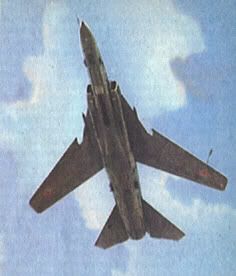
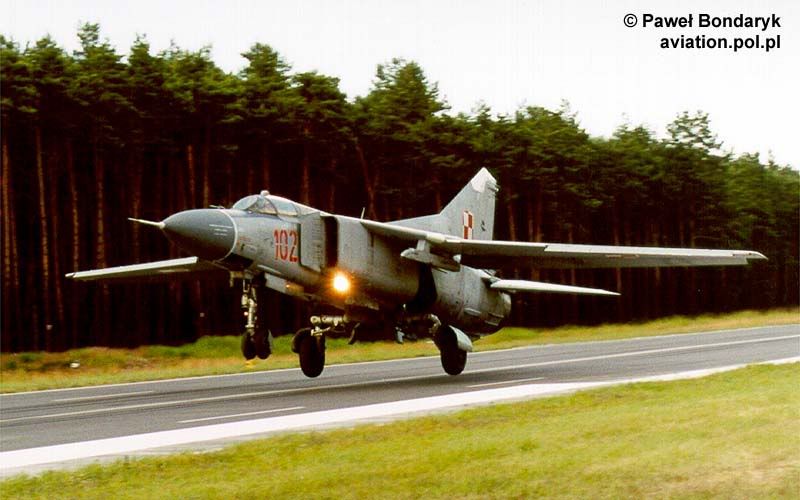
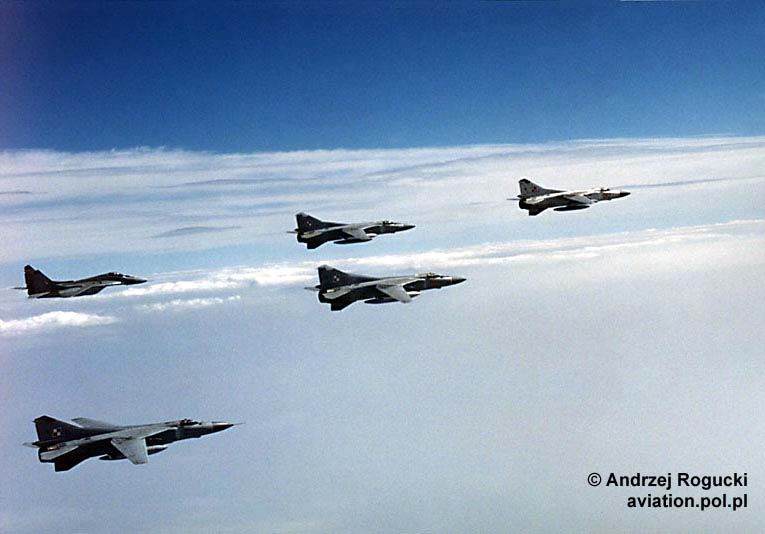
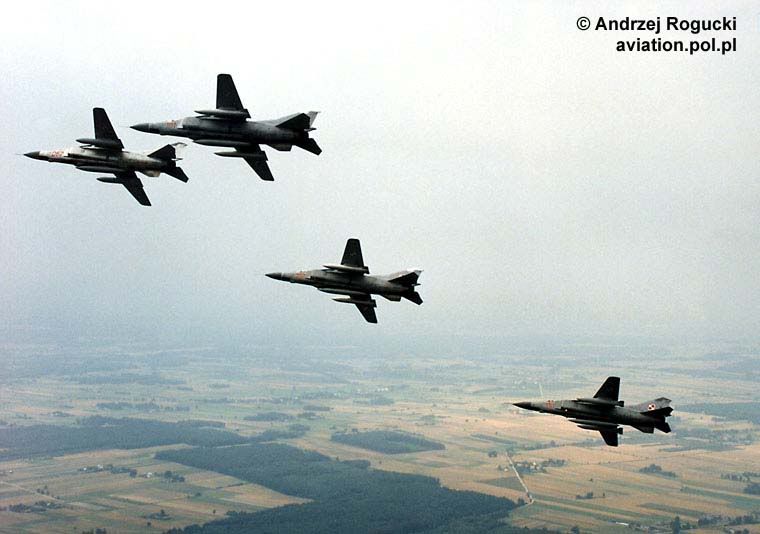
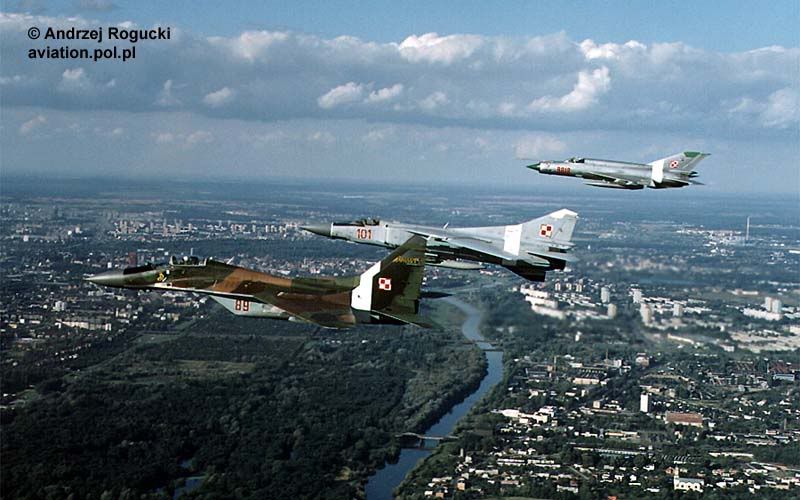
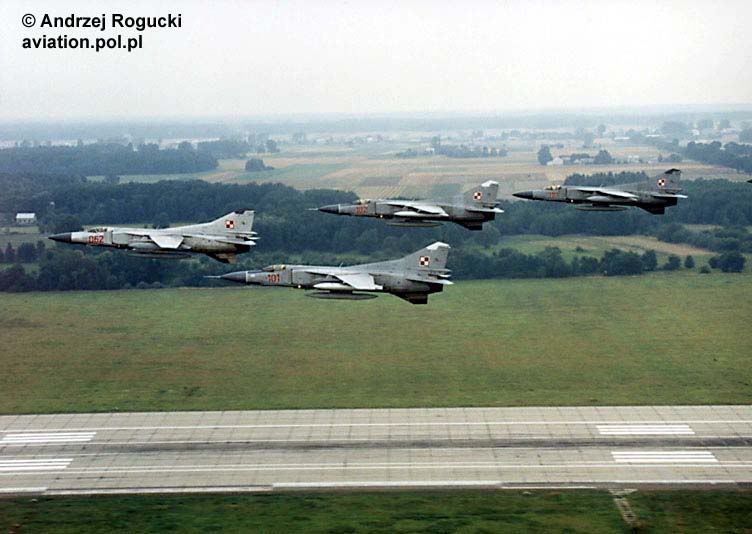
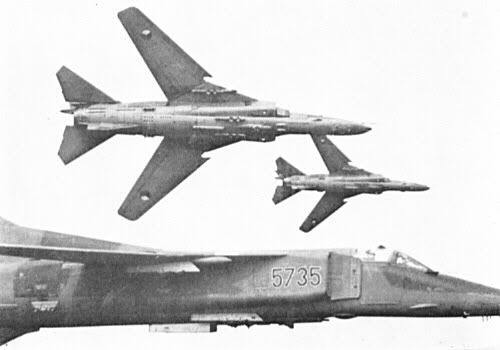


![[009]](./images/smilies/009.gif) .
.



